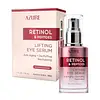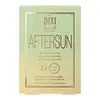What's inside
What's inside
 Key Ingredients
Key Ingredients

 Benefits
Benefits

 Concerns
Concerns

No concerns
 Ingredients Side-by-side
Ingredients Side-by-side

Water
Skin ConditioningGlycerin
HumectantPropylene Glycol
HumectantBetaine
HumectantSoluble Collagen
HumectantRetinol
Skin ConditioningCopper Tripeptide-1
Skin ConditioningAcetyl Hexapeptide-8
HumectantPalmitoyl Pentapeptide-4
Skin ConditioningSodium Hyaluronate
HumectantPanthenol
Skin ConditioningMacadamia Ternifolia Seed Oil
EmollientBrassica Campestris Sterols
EmollientCeteth-3
EmulsifyingCeteth-5
EmulsifyingTocopheryl Acetate
AntioxidantPotassium Cetyl Phosphate
EmulsifyingBeta-Glucan
Skin ConditioningHydroxyethyl Urea
HumectantAloe Barbadensis Leaf Extract
EmollientButylene Glycol
HumectantHydrogenated Lecithin
EmulsifyingSodium Ascorbyl Phosphate
AntioxidantPolyglyceryl-10 Oleate
Skin ConditioningCaprylic/Capric Triglyceride
MaskingCholesterol
EmollientPolysorbate 20
EmulsifyingPEG-60 Hydrogenated Castor Oil
EmulsifyingGlyceryl Acrylate/Acrylic Acid Copolymer
HumectantAlcohol
AntimicrobialEthylhexylglycerin
Skin Conditioning1,2-Hexanediol
Skin ConditioningPhenoxyethanol
PreservativeParfum
MaskingWater, Glycerin, Propylene Glycol, Betaine, Soluble Collagen, Retinol, Copper Tripeptide-1, Acetyl Hexapeptide-8, Palmitoyl Pentapeptide-4, Sodium Hyaluronate, Panthenol, Macadamia Ternifolia Seed Oil, Brassica Campestris Sterols, Ceteth-3, Ceteth-5, Tocopheryl Acetate, Potassium Cetyl Phosphate, Beta-Glucan, Hydroxyethyl Urea, Aloe Barbadensis Leaf Extract, Butylene Glycol, Hydrogenated Lecithin, Sodium Ascorbyl Phosphate, Polyglyceryl-10 Oleate, Caprylic/Capric Triglyceride, Cholesterol, Polysorbate 20, PEG-60 Hydrogenated Castor Oil, Glyceryl Acrylate/Acrylic Acid Copolymer, Alcohol, Ethylhexylglycerin, 1,2-Hexanediol, Phenoxyethanol, Parfum
Water
Skin ConditioningGlycerin
HumectantBetaine
HumectantNiacinamide
SmoothingPanthenol
Skin ConditioningTremella Fuciformis Extract
HumectantAllantoin
Skin ConditioningAscorbic Acid
AntioxidantCucumis Sativus Fruit Extract
EmollientChamomilla Recutita Extract
Skin ConditioningAloe Barbadensis Leaf Extract
EmollientPhellinus Linteus Extract
Skin ConditioningChamomilla Recutita Flower Extract
MaskingArctium Lappa Root Extract
Skin ConditioningMadecassoside
AntioxidantCeramide NP
Skin Conditioning1,2-Hexanediol
Skin ConditioningDipotassium Glycyrrhizate
HumectantOctyldodecanol
EmollientTrehalose
HumectantHydrogenated Lecithin
EmulsifyingEthyl Hexanediol
SolventHydroxyethylcellulose
Emulsion StabilisingCaprylyl Glycol
EmollientPhenoxyethanol
PreservativeWater, Glycerin, Betaine, Niacinamide, Panthenol, Tremella Fuciformis Extract, Allantoin, Ascorbic Acid, Cucumis Sativus Fruit Extract, Chamomilla Recutita Extract, Aloe Barbadensis Leaf Extract, Phellinus Linteus Extract, Chamomilla Recutita Flower Extract, Arctium Lappa Root Extract, Madecassoside, Ceramide NP, 1,2-Hexanediol, Dipotassium Glycyrrhizate, Octyldodecanol, Trehalose, Hydrogenated Lecithin, Ethyl Hexanediol, Hydroxyethylcellulose, Caprylyl Glycol, Phenoxyethanol
 Reviews
Reviews

Ingredients Explained
These ingredients are found in both products.
Ingredients higher up in an ingredient list are typically present in a larger amount.
1,2-Hexanediol is a synthetic liquid and another multi-functional powerhouse.
It is a:
- Humectant, drawing moisture into the skin
- Emollient, helping to soften skin
- Solvent, dispersing and stabilizing formulas
- Preservative booster, enhancing the antimicrobial activity of other preservatives
Aloe Barbadensis Leaf Extract is an extract of the leaves of the aloe, Aloe barbadensis, Liliaceae.
Aloe is one of the most well-known natural soothing ingredients, and for good reason. It’s full of water and has a cooling, calming effect on the skin, especially when it’s sunburned, itchy, or irritated. Aloe also helps your skin stay hydrated and smooth by mimicking what healthy skin naturally produces. On top of that, it contains vitamins and nutrients that support skin recovery.
It doesn’t protect you from the sun, but it can help your skin bounce back after too much time in it.
Let’s get into the details:
Aloe contains antioxidant Vitamins A, C, and E, which help fight off free radicals (unstable molecules from things like pollution that can damage your skin).
It’s also rich in polysaccharides, which are natural sugars that help hydrate the skin by acting like the skin’s own moisturizing agents. These, along with other sugars like monosaccharides, help form a protective barrier that locks in moisture.
Aloe works as both a humectant and an emollient. That means it draws water into the skin (humectant) and helps trap it there (emollient), making it an effective natural moisturizer.
You’ll also find a mix of other skin-supporting ingredients in aloe, including folic acid, choline, calcium, amino acids, fatty acids, and even Vitamin B12.
Out of the 420+ species of aloe, Aloe barbadensis is the most widely used in skincare products thanks to its gentle yet effective properties.
There are over 420 species of aloe but Aloe Barbadensis is the most commonly used for topical products.
Learn more about Aloe Barbadensis Leaf ExtractBetaine is a common humectant (a substance that promotes retention of moisture). It's known to be gentle on the skin and can help balance hydration.
This ingredient is best for improving hydration and soothing irritated skin. Studies also show it helps even out skin tone.
Fun fact: Betaine is naturally created in the skin and body. The kind found within cosmetic products can be either plant-derived or synthetic.
Another name for betaine is trimethylglycine.
Learn more about BetaineGlycerin is already naturally found in your skin. It helps moisturize and protect your skin.
A study from 2016 found glycerin to be more effective as a humectant than AHAs and hyaluronic acid.
As a humectant, it helps the skin stay hydrated by pulling moisture to your skin. The low molecular weight of glycerin allows it to pull moisture into the deeper layers of your skin.
Hydrated skin improves your skin barrier; Your skin barrier helps protect against irritants and bacteria.
Glycerin has also been found to have antimicrobial and antiviral properties. Due to these properties, glycerin is often used in wound and burn treatments.
In cosmetics, glycerin is usually derived from plants such as soybean or palm. However, it can also be sourced from animals, such as tallow or animal fat.
This ingredient is organic, colorless, odorless, and non-toxic.
Glycerin is the name for this ingredient in American English. British English uses Glycerol/Glycerine.
Learn more about GlycerinHydrogenated Lecithin is created from the hydrogenation of lecithin (a group of phospholipids). Hydrogenation is a chemical reaction between hydrogen and another element.
This ingredient is an emollient and emulsifier. As an emollient, it helps soften skin by trapping moisture within. As an emulsifier, it prevents oil and water ingredients from separating.
Panthenol is a common ingredient that helps hydrate and soothe the skin. It is found naturally in our skin and hair.
There are two forms of panthenol: D and L.
D-panthenol is also known as dexpanthenol. Most cosmetics use dexpanthenol or a mixture of D and L-panthenol.
Panthenol is famous due to its ability to go deeper into the skin's layers. Using this ingredient has numerous pros (and no cons):
Like hyaluronic acid, panthenol is a humectant. Humectants are able to bind and hold large amounts of water to keep skin hydrated.
This ingredient works well for wound healing. It works by increasing tissue in the wound and helps close open wounds.
Once oxidized, panthenol converts to pantothenic acid. Panthothenic acid is found in all living cells.
This ingredient is also referred to as pro-vitamin B5.
Learn more about PanthenolPhenoxyethanol is a preservative that has germicide, antimicrobial, and aromatic properties. Studies show that phenoxyethanol can prevent microbial growth. By itself, it has a scent that is similar to that of a rose.
It's often used in formulations along with Caprylyl Glycol to preserve the shelf life of products.
Water. It's the most common cosmetic ingredient of all. You'll usually see it at the top of ingredient lists, meaning that it makes up the largest part of the product.
So why is it so popular? Water most often acts as a solvent - this means that it helps dissolve other ingredients into the formulation.
You'll also recognize water as that liquid we all need to stay alive. If you see this, drink a glass of water. Stay hydrated!
Learn more about Water